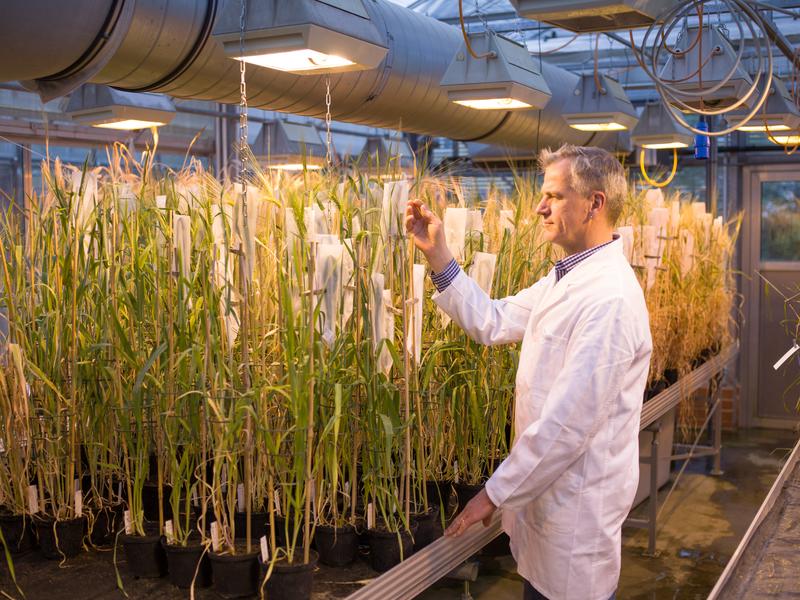
Wild Wheat Genome Sequencing Provides ‘Time Tunnel’ Capable of Boosting Future Food Production

Nils Stein observes cereal plants in the greenhouse
IPK/Sebastian Mast
The study was led by Dr. Assaf Distelfeld of Tel Aviv University’s School of Plant Sciences and Food Security and Institute for Cereal Crops Improvement, in collaboration with scientists from several dozen institutions around the world and Israeli based company – NRGene, who developed the bioinformatics technology that accelerated the research just published in Science magazine.
“This research is a synergistic partnership between public and private entities,” said Daniel Chamovitz, PhD, Dean, George S. Wise Faculty of Life Sciences, Tel Aviv University, who was also involved in the research. “Ultimately, this research will have a significant impact on the global food supply and world hunger.”
“Our ability to generate the wild emmer wheat genome sequence so rapidly is a huge step forward in genomic research,” said Curtis Pozniak, PhD, Professor, Ministry of Agriculture Strategic Research Program Chair, University of Saskatchewan, and a project team member. “Wheat accounts for almost 20% of the calories humans consume worldwide, so a strong focus on improving the yield and quality of wheat is essential for our future food supply.”
“From a biological and historical viewpoint, we have created a ‘time tunnel’ that we can use to examine wheat from before the origins of agriculture,” said Dr. Distelfeld. “Our comparison to modern wheat has enabled us to identify the precise genes that allowed domestication – the transition from wheat grown in the wild to modern day varieties. While the seeds of wild wheat readily fall off the plant and scatter, a change in two genes meant that in domesticated wheat, the seeds remained attached to the stalk, and it is this trait that enabled humans to harvest wheat.”
“This new resource allowed us to identify a number of other genes that control main traits that were selected by early humans during wheat domestication and that served as foundation for developing modern wheat cultivars” said Dr. Eduard Akhunov of Kansas State University. “These genes provide invaluable resource for empowering future breeding efforts. Wild emmer is known as a source of novel variation that can help to improve the nutritional quality of grain, and tolerance to diseases and water-limiting conditions”
The new genomic tools are already being implemented to identify new genes for wheat production improvement under changing environment, explains Dr. Zvi Peleg of the Hebrew University of Jerusalem, Israel. “While many modern wheat cultivars are susceptible to water stress, wild emmer has undergone long evolutionary history under the drought-prone Mediterranean climate. Thus, utilization of the wild genes in wheat breeding programs will promote producing more yield for less drop.”
“The wild emmer wheat genome is much more complex than most of the other crops and has a genome which is more than three times the size of a human genome.” said Gil Ronen, NRGene’s CEO. “Still, the computational technology we have developed has for the first time allowed us to assemble a large and complex genome to a standard never achieved before”.
For the first time, the sequences of the 14 chromosomes of wild emmer wheat are collapsed into a refined order, thanks in part to 3D conformation capture sequencing, a technology originally tested in humans and recently demonstrated in barley, both of which have smaller genomes than wild emmer wheat. “These innovative technologies have changed the game in assembling the large cereal genomes, if not in general”, says Nils Stein, Head of the research group Genomics of Genetic Resources at Leibniz Institute of Plant Genetics and Crop Plant Research (IPK), Germany.
“This sequencing approach used for wild emmer wheat is unprecedented, and has paved the way to sequence durum wheat (the cultivated form of wild emmer). Now we can better understand how humanity was able to transform this wild plant into a modern high yielding durum wheat” said Luigi Cattivelli, co-author of the work and coordinator of the International Durum Wheat Genome Sequencing Consortium.
“We now have the tools to study crops directly and to make and apply our discoveries more efficiently than ever before,” concluded Dr. Distelfeld.
Publication:
Avni R, Nave M, Barad O, Twardziok SO, Gundlach H, Hale I, Mascher M, Spannagl M, Wiebe K, Jordan KW, Golan G, Deek J, Ben-Zvi B, Baruch K, Ben-Zvi G, Himmelbach A, MacLachlan RP, Sharpe AG, Fritz A, Ben-David R, Budak H, Fahima T, Korol A, Faris JD, Hernandez A, Mikel MA, Levy A, Steffenson B, Maccaferri M, Tuberosa R, Cattivelli L, Faccioli P, Ceriotti A, Kashkush K, Pourkheirandish M, Komatsuda T, Eilam T, Sela H, Sharon A, Ohad N, Chamovitz DA, Mayer KFX, Stein N, Ronen G, Peleg Z, Pozniak CJ, Akhunov ED, Distelfeld A (2017) Wild emmer genome architecture and diversity elucidate wheat evolution and domestication. Science
doi: 10.1126/science.aan0032












